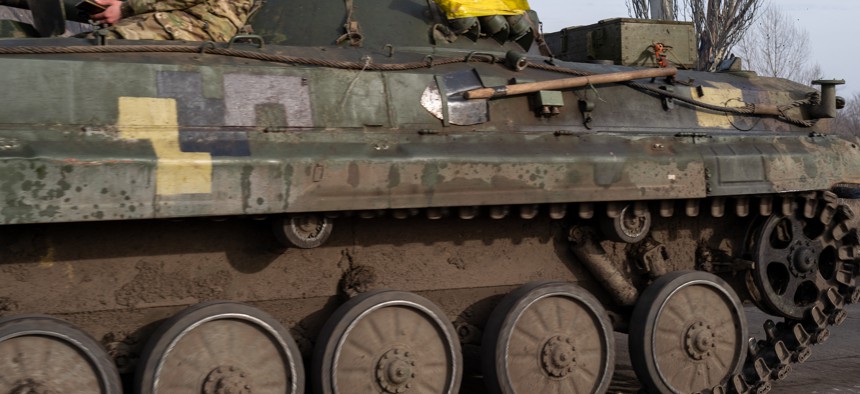
A tank drives down a road in the mining town of Toretsk, Ukraine, which is situated less than 20 miles from the front lines, on January 20, 2023. Getty Images / Spencer Platt
Germany Resists US, Allied Pressure to Allow Leopard 2 Tanks to Go to Ukraine
German, U.S. officials deny that Berlin would relent if the Pentagon donates Abrams tanks.
A Friday meeting of Ukraine-supporting governments ended without Germany giving Poland the OK to transfer German-made tanks to Kyiv.
U.S. officials subsequently tried to downplay that outcome of the 54-nation confab at Ramstein Air Base.
“This isn’t really about one single platform,” U.S. Defense Secretary Lloyd Austin said Friday after the meetings. “Our goal…is to provide the capability that Ukraine needs to be successful in the near term.”
Asked whether Germany was “doing enough to show real leadership in Europe,” Austin responded, “Yes, but we can all do more. The United States and every other member of the [allies] can do more.”
Poland has offered to send some of its Leopard 2 tanks to Ukraine, but export licenses forbid their transfer without German approval.
Earlier this week, the United Kingdom said it would send 14 of its Challenger 2 main battle tanks to the beleaguered country.
“This is the first introduction of Western main battle tanks into Ukraine,” Austin said. “I…commend our British allies for making this decision.”
German Defense Minister Boris Pistorius denied reports that Germany wants the U.S. to offer some of its Abrams tanks before it approves the Leopard transfers.
Austin appeared to concur: “This notion of unlocking , in my mind, is not an issue.”
Pressure has been mounting on Germany to approve the Polish tank transfer. Pistorius told reporters that Berlin “will make our decisions as soon as possible.”
The U.S. has been hesitant to send Abrams tanks, in part, because of their heavy maintenance and logistics needs.
“This is a tank that…requires jet fuel, whereas the Leopard and the Challenger [have] a different engine,” Deputy Pentagon Press Secretary Sabrina Singh said Thursday. They require diesel [fuel]. It's a little bit easier to maintain. They can maneuver across large portions of territory before they need to refuel.”
U.S. officials have taken a methodical approach to sending arms to Ukraine, stressing the need to train Ukrainian forces on the specific weapons before sending them en masse.
Still, the U.S. has been broadening the types of armor and other weapons it releases to Ukraine. On Thursday, Washington authorized $2.5 billion in new weapons transfers, including 59 Bradley infantry fighting vehicles, 90 Stryker armored personnel carriers, 53 MRAPs, and 350 Humvees. It also includes NASAMS missiles and Avenger interceptors.
Officials from 54 countries supporting Ukraine met this week for the eighth time since Russia’s invasion.
“Today’s meeting focused on Ukraine’s needs for air defense and armor,” Austin said. “We also pushed hard on how to synchronize those donations and turn them into fully operational capabilities—and that means every step from donation to training to maintenance and then to sustainment.”
Austin praised Germany and the Netherlands for sending Patriot missile interceptors to Ukraine.
NEXT STORY: US, Allies Push Armor and Rockets Into Ukraine



